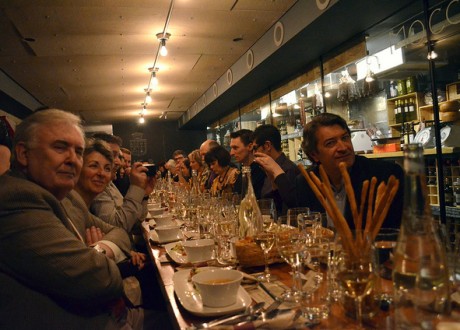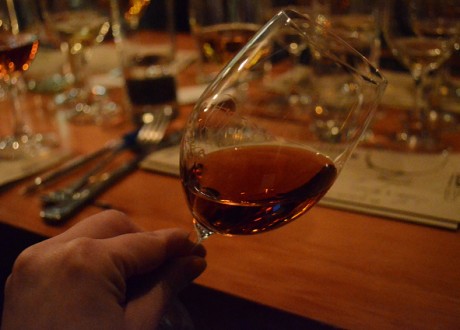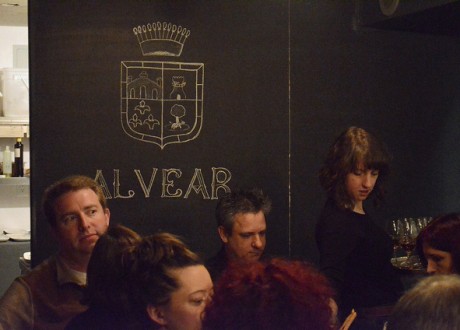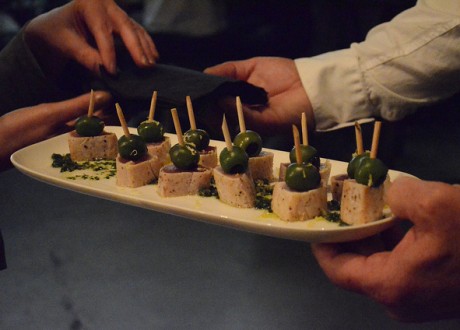VPIWF: Sabor de España at Salt Tasting Room
Posted by Degan Walters on Tuesday, March 29th, 2011Tags for this Article: festival, salt, Spanish, tasting, vancouver, Wine

The Vancouver International Playhouse Wine Festival kicked off yesterday and my first event was Sabor de España! at Salt Tasting Room in Gastown. This was to be a Spanish feast paired with a selection of Bodegas Alvear wines from the Montilla region, presented by Fernando and Maria Alvear.
Way back in January, Harry Hertscheg promoted the Wine festival with the suggestion that a fino sherry would make a fine drink for a reception and here we started off the evening with Alvear’s Fino C.B. Named for Carlos Billanueva, the cellar master from 1810, its round flavours are typical of Montilla and was a beautiful wine to start with.
But Montilla is not in Jerez so these are not sherries, and – except for the oloroso – not fortified either.
Sherry is a fortified wine and it must come from the Jerez region in Spain in order to take part in that category but it comes in several styles – fino, amontillado and oloroso. Hopefully I can get more into fortified wines later in the week, as it’s a theme of the festival this year.
As Fernando Alvear, CEO, explained, most of their wines are made only with Pedro Ximenez grapes. In Andalusia it is so hot that these grapes and olives are the main agricultural products. It’s very thin skin – so thin you can see the pit through the grape! – means it can be easily over-matured to take advantage of the natural sugars. As well, the thin skin means that it’s easy to take the liquid out of the fruit and dry them into raisins – resulting in some of the wines we had later in the evening – and meaning that a non-fortified sherry-style wine can be produced.

The fino is a very dry wine the colour of pale straw. After the aperitif Fino C.B. there were two more – Fino en Rama 2004 and Capataz Fino – to go with our meal of charred octopus salad and preserved heirloom tomato gazpacho.
“Rama” means unfiltered and aged without blending in a single vintage, whereas the Capataz is a very old fino in the same style as the C.B. These are very dry wines, designed to go well with high levels of acid, so the gazpacho was a perfect pairing. A lot of the saltiness of the food just disappeared with the wine.

The next course was braised beef short ribs two ways in an “Estofado de Catalan” style. One was prepared in a sweet and sour raisin and almond gastrique while the other was accompanied by bitter rapini and buttery celeriac mash and both broke apart decadently when nudged with a fork. The wines to be paired with dinner were Carlos VII Amontillado and the Asuncion Oloroso.
Amontillado is the next darkest drink after the fino (but before the oloroso) and Fernando suggests it is a good aperitif because unlike the fino that you have to serve with food, the amontillado can be served by itself and people will nurse it through the cocktail hour. He says “Oloroso goes with everything but amontillado is very special.” The Carlos VII is very old (approximately 20 years) and had an element of sharpness under the sugar.
The oloroso is even darker, almost bronze-coloured in the glass and this one is fortified and aged in oak in the style of sherry. It had a sweet, caramel nose – spun sugar with a hint of bitterness – and went very well with the raisin sauce on the beef.
Finally for dessert, we had Pedro Ximenez Anada 2008 and the Pedro Ximenez Solera 1927. Interestingly, both wines are made from raisins instead of grapes. The raisins are dried in the sun, ground into must and then fermented and this process must leave a tell-tale mark on the wines because they were quite different but both tasted powerfully of raisins. The PX Anada was a very clear wine, with hints of marmalade and bitter orange while the Solera thick and cloying and languid. The Solera is Spain’s most popular brand of Pedro Ximenez and is a classic PX with some olorosa.
To pair with these wines Chef Alvin created a dessert platter with a variety of flavours; a piece of powerful Valdeon blue cheese, some honeyed almonds, a selection of cookies and a salted caramel chocolate terrine. This dish could have been better paired, I thought. The cheese wrestled with the wine on the palate and the rest of the flavours were washed out by the oloroso. But then I’m not much of a dessert person, so I was happy to sit back and sip.
Salt Tasting Room will be carrying both the Rama and Capataz finos (as well as the Fino C.B. when it’s released in May) and the Pedro Ximenez Solera 1927.



